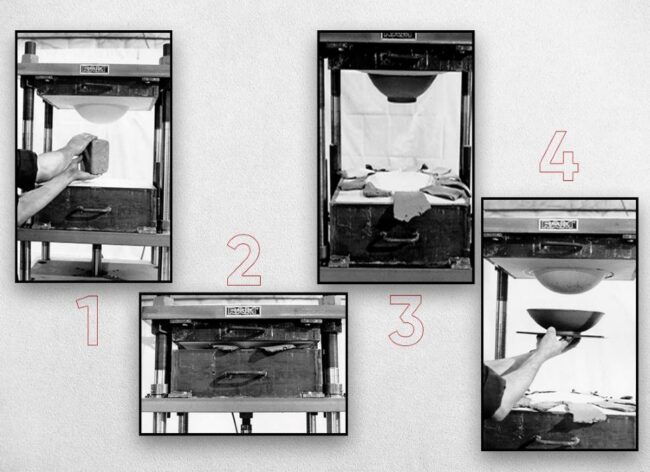What is RAM Press
Did you already know that porous resin is as well used for RAM Press process? With just the right know-how, porous resin molds are able to replace traditional plaster molds therefore being more accurate and more permanent. A porous resin mold ensures a long mold life and a high level of permeability to improve production processes
Process
In a RAM press machine, a ceramic body is shaped by pressing clay into molded shapes such as plates and bowls. The clay is placed between two halves of a mold (usually a male and a female). Then pressed into the required shape. Any imperfections of the surface can be cut away or removed with a wet sponge. Once a body is finished, it may then be decorated, glazed. And finally fired in the kiln.
The clay should be slightly stiff while still having water retention properties. That allows the body to form easily during the pressing cycle. The pressure that is required is subject to various conditions. Such as the thickness of the pressed piece. But usually falls fall within the range of 100 to 400 psi.
The molds that are being used are traditionally made of porous plaster/ gypsum cement embedded with porous tubes/air hoses. The pressed shape is instantly released by applying fluid pressure. Nowadays, more and more manufacturers realize the benefits being provided by porous resin molds compared to traditional plaster molds.
The process shown in operation in the series of photos and video below is semi-automatic requiring a minimum of manual operation.
Ram Press On Action – Castimo – YouTube
What can be produced with RAM Press
A RAM press can be used to produce complex shapes in a variety of sizes. Basically any shape that can be made in a two-piece mold can be used for Ram Press. Many companies in the ceramic fields are using the RAM process, this includes amongst others
- table ware
- sanitary ware
- oxide ceramics
- art ware
- electrical porcelain
- structural clay products
Appendages such as knobs and handles are applied directly on the formed body and holes may be punched simultaneously with the pressing process.
Advantages of RAM Press
Due to standardized production process and minimal manual operation, each piece of ceramic body is of uniform quality, thereby keeping the number of rejects from the forming to the kiln at a bare minimum. How much manual finishing is required after the ceramic body is removed from the press depends on the quality of the two halves of the mold.
With a RAM press an immediate increase in production can be achieved. Press cycle rates depend on a number of factors and with the present RAM pressing equipment 5 to 6 pressing cycles per minute can be achieved, with the average being 1,500 cycles in an eight-hour shift. Change over from one mold to another is done at the RAM press in a matter of minutes.

RAM Press molds
The RAM process mold life expectancy is very much dependent on the quality of the produced mold. The mold making process but also on the body type used, body consistency and dewatering required. Plaster mold life ranges usually from 1000 to 5000 pressings. Porous resin mold life expectation is considerably greater and can be reused during a significant time span, given that regular maintenance is being applied.
Porous resin RAM Press molds
As a result compared to traditional plaster molds, porous resin RAM Press molds are characterized by
- Considerably improved mold life expectation: less changing cycles due to exhausted molds
- Limited expansion of every RAM press product
Advantageous mechanical properties and required permeability to release excess water
https://www.instagram.com/castimogmbh/
https://www.linkedin.com/company/castimogmbh/

